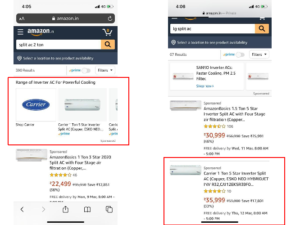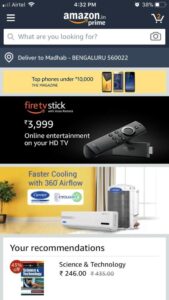Planning for Amazon sponsored ads success?
You must start by identifying and setting objectives for the Amazon Marketing Services (AMS) or display campaigns.
The long-term goals to advertising remain fundamentally same here too i.e.:
Awareness – Tell your brand story and reach maximum potential audience base
Consideration – Reach audience who are in research mindset phase about your category
Conversions – Target high-intent users who are more likely to buy your product by moving from consideration phase
Loyalty – Drive repeat purchase from customers
Hence, it becomes crucial for brands to firstly identify and set actionable objectives in order to achieve the above goals. So here are some objectives that you should consider while planning your next Amazon advertising campaign:
1) Protect – Defend the brand keywords and increase loyalty
As a subset of conversions and loyalty goal, protecting your brand keywords becomes extremely important. Here the user has already considered your product, hence conversion becomes an easier job. For brand keywords, you should bid for the top placements using ad types like sponsored brand and sponsored product. The parameters of measuring performance would be ROAS, CPA, ACOS and SOV. If we have covered these parameters, then you’re on the right track in protecting the brand keywords.
Actionable goal example – Increase SOV on brand keywords by 30% in next two months

2) Expand – Expand Product Visibilityto the audience within the category
As a subset of brand awareness goal, generating maximum impressions and driving traffic to the product details page becomes important. The consumer has a need and is bombarded with multiple product options while browsing that category. You need to expand your product visibility in order to engage that consumer using a mix of AMS ad units like sponsored brand, sponsored product and display campaigns.
The performance measuring parameters here would be SOV, Traffic. The focus here should be on high-traffic keywords and ASINs that appear organically in search results.
Actionable goal example – Grow impressions in category by 30% in next two months

3) Conquest – Competition Targeting
As a subset of consideration goal, competition targeting helps you to increase your market share in the category. While initially you might see higher CPCs and lower CTR% rates, as shoppers may have made up their mind on the product they want already. But in the longer run, it will start yielding results by expanding market share and customer base. The performance measuring parameters here would be CTR% and CPC. One should target your competition ASINs with products which are better priced, have better features, or better review ratings. Here, Product selection is most important. You need to think like a customer and ask yourself “Would I buy this product if I was in the customer’s shoes?”
Actionable goal example – Increase CTR% on competitive keywords for the next 5 weeks

4) Launch – Support new product promotion
Launching a new product and making it successful requires maximum eyeballs so that a large number of people get to know about your product. As a subset of awareness goal, you want to generate maximum impressions and drive traffic to your product details page. The performance measuring parameters here would be SOV and Traffic. And the focus should be on high-traffic keywords and ASINs that appear organically in search results. It needs to have the right balance between Display and Sponsored brand + Sponsored product campaigns. If the product is seasonal, keep focus more on display as you can control CPCs here.
Actionable goal example – Bring 0.1Mn traffic to the product details page in the next 45 days.

5) Cross Sell – Diversify promotions across your product portfolio
Expand your product range by complementing an existing product with a related one.
An example: the person who bought a camera may also buy a tripod. Amazon attributes 35% of its sales through cross-selling by using the phrases like “Customers who bought this item also bought” and “Frequently bought together”. You should create campaignsthat target keywords to adjacent product categories.

6) Upsell – Promote higher priced products or selling more
Encourage your customer to purchase a more expensive product in the same product family. Marking out the features that make your product more attractive for purchase should be highlighted. Also, for larger sized products, campaigns keywords should have ‘combo/multi-pack’. Similarly, the landing page should contain combo/multi-pack buying as the only option. If the user is searching for a multi-pack of snacks but ends up with a single pack on the landing page , you are bound to lose that conversion. Create separate campaign in Amazon Marketing Services account with keywords including bulk, combo, or multi-pack.

7) Promote – Boost Amazon Lightning deal/Discount coupons with Amazon
Create separate campaigns for ASINs with lightning deals and discount coupons to improve sale numbers. As a subset of conversion goal, performance parameters here would be ROAS and ASP.

Conclusion
Establishing unique and actionable objectives helps maximise product awareness, drive new customer growth, maximise revenue opportunities and maintain connection with your loyal customers.
At the outset of any Amazon campaign, think of the overarching goal and then break it into actionable objectives.
Molly leads the media and ecomm practice at Bottle Openers

